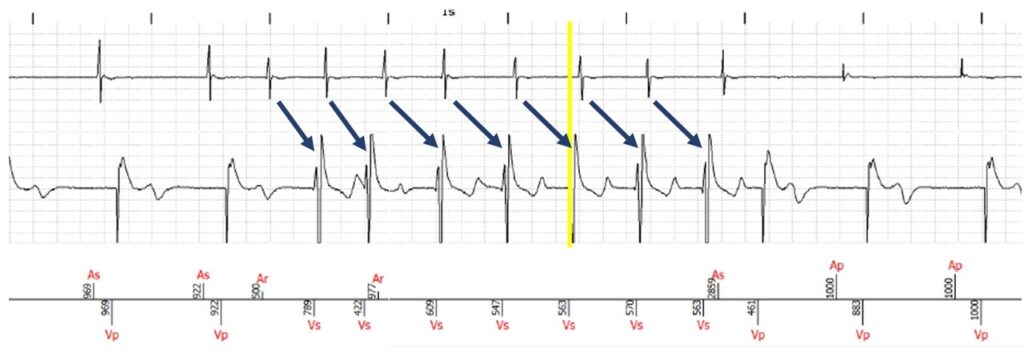Ventricular run 2
Case Summary
0 of 1 Questions completed
Questions:
Information
You have already completed the case before. Hence you can not start it again.
Case is loading…
You must sign in or sign up to start the case.
You must first complete the following:
Results
Results
Time has elapsed
Categories
- Not categorized 0%
-
Fullscreen Mode
Ventricular run
As explained in the previous case, a succession of fast ventricular events triggers the recording of an episode classified as “ventricular run”. It does not necessarily mean it is truly a nonsustained ventricular tachycardia (NSVT) because no discrimination algorithm has been activated to evaluate if the fast ventricular events originate from the atrium (supraventricular tachycardia) or from the ventricle (NSVT). In this case, many atrial events are undersensed, not because they are small in amplitude, but because they occur during blanking periods just after ventricular events.
Paroxysmal atrial tachycardia
In this case, there are not more ventricular events than atrial events, therefore the diagnosis is more difficult. After careful examination of the atrial EGM, we see that there are as many fast atrial events as ventricular events, making it a 1-to-1 tachycardia. Therefore we can exclude atrial fibrillation as a diagnosis (in this case, there would be many more atrial events than ventricular events). We now need to carefully evaluate the assocation between the atrium and the ventricle. The fast ventricular events are in fact preceded by atrial events. The first fast event is in the atrium and the last fast event is in the ventricle. There is a prolongation of the interval between A and V, which is typical Wenckebach phenomenon (shown by blue arrows in the figure). As the last atrial event is slightly slower, it does not occur during a blanking and is sensed. Since the programmed AV interval is shorter than the PR interval, we see a ventricular paced beat. The diagnosis of paroxysmal atrial tachycardia can now be firmly made.
Paroxysmal atrial tachycardia: fast ventricular events are preceded by fast atrial events, which are often functionally undersensed.
Clinical implication
Atrial runs, or short bursts of paroxysmal atrial tachycardia, are commonly recorded by pacemakers. When patients are symptomatic, these recorded episodes may aid in delivering a diagnosis. Most often however, patients are asymptomatic, warranting no specific treatment of the short arrhythmia. While atrial extrasystoles or bursts of atrial tachycardia are associated with a risk of developing AF, medical treatment is not considered to prevent ocurrence of sustained arrhythmia. Also is there no indication for anticoagulation, such as there is for long episodes of atrial fibrillation.
- 1
- Current
- Review / Skip
- Answered
- Correct
- Incorrect
-
Question 1 of 1
1. Question
CorrectIncorrect


